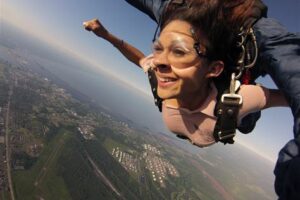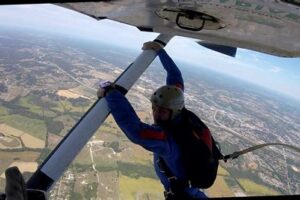Table of Contents
Discover the average skydiving height and experience the exhilarating rush of adrenaline as you freefall from thousands of feet above ground. Whether you’re a seasoned adventurer or a first-time jumper, explore the optimal altitude for skydiving and prepare for an unforgettable adventure in the sky.
Skydiving is an exhilarating experience that pushes our limits and allows us to defy gravity. Whether you are a seasoned jumper or a first-time adventurer, understanding the average skydiving height is crucial for a safe and memorable descent. So, let’s dive right in and explore the heights at which these adrenaline junkies take their leap of faith!
The Average Skydiving Height: A Thrilling Adventure in the Skies
When it comes to adrenaline-pumping activities, few can match the exhilaration of skydiving. This extreme sport allows individuals to experience the ultimate rush as they jump out of an aircraft and freefall through the sky. However, many people wonder about the average skydiving height and what factors play a role in determining it. In this article, we will explore the average skydiving height, the variations that exist, and the reasons behind them.
Understanding Skydiving Altitudes
Before delving into the average skydiving height, it is important to understand the concept of skydiving altitudes. Skydiving typically involves two main altitudes: exit altitude and deployment altitude.
The Exit Altitude
The exit altitude, also known as the drop zone altitude, refers to the height at which skydivers exit the aircraft. This altitude varies depending on several factors, including the type of skydive, the equipment used, and the regulations of the specific skydiving facility. However, the average exit altitude for recreational skydiving typically ranges from 10,000 to 13,000 feet above ground level (AGL).
The Deployment Altitude
Once the skydiver exits the aircraft, they experience an exhilarating freefall until reaching the deployment altitude. The deployment altitude is the height at which the skydiver deploys their parachute. Similarly to the exit altitude, the deployment altitude can vary depending on factors such as the type of skydive and the preferences of the individual skydiver. On average, skydivers deploy their parachutes at around 5,000 feet AGL.
Factors Affecting Skydiving Heights
While the average skydiving height ranges mentioned above provide a general overview, it is important to note that various factors can influence these heights. Some of the key factors affecting skydiving heights include:
Regulations and Safety Standards
Skydiving is a highly regulated activity, governed by strict safety standards. These regulations dictate the minimum altitudes at which skydivers must deploy their parachutes. Different countries and regions may have varying safety standards, resulting in differences in average skydiving heights.
Experience Level
The experience level of the skydiver can also impact the average skydiving height. Novice skydivers often start with lower altitudes, allowing them to acclimate to the sport gradually. As they gain more experience and proficiency, skydivers may progress to higher exit and deployment altitudes.
Types of Skydives
The type of skydive being performed can also influence the average skydiving height. For example, tandem skydives, where a student skydiver is attached to an instructor, often have lower exit altitudes than solo or advanced skydives.
The Thrill of Reaching New Heights
Regardless of the specific skydiving height, every jump offers a unique and thrilling experience. The rush of adrenaline, the breathtaking views, and the sense of absolute freedom make skydiving an unforgettable adventure. Whether you choose to start with a lower exit altitude or aim for the highest heights, skydiving promises an extraordinary journey through the skies.
Overcoming Fear and Embracing the Unknown
Skydiving is not only about soaring through the skies but also about facing fears and stepping out of your comfort zone. The moment you take that leap of faith, you conquer your apprehensions and embrace the unknown. It is this triumph over fear that makes skydiving an incredibly empowering experience.
The Importance of Professional Training
Before embarking on any skydiving adventure, it is crucial to undergo professional training. Skydiving schools and instructors provide comprehensive courses that equip you with the necessary skills and knowledge to safely enjoy this thrilling activity. Proper training ensures that you understand the importance of altitude, safety procedures, and equipment usage.
In Conclusion
The average skydiving height may vary depending on several factors such as regulations, experience level, and the type of skydive being performed. However, what remains constant is the incredible exhilaration and sense of freedom that skydiving offers. Whether you choose to start small or aim for the highest altitudes, skydiving promises an adventure like no other.
What is Skydiving Height?
Skydiving height refers to the altitude at which individuals exit the aircraft and start their freefall. It is the distance between the ground and the point of exit, typically measured in feet or meters.
The Usual Starting Altitude
The average skydiving height for beginners is around 10,000 to 13,000 feet (3,048 to 3,962 meters) above ground level. This starting altitude ensures a thrilling freefall experience while allowing sufficient time for parachute deployment and a safe landing.
Factors Affecting Skydiving Height
The choice of skydiving height may depend on several factors, including the type of jump (tandem, solo, or sport), the experience level of the skydiver, weather conditions, airspace restrictions, and the desired duration of freefall.
Tandem Skydiving Height
In tandem skydiving, where a novice skydiver is attached to an experienced instructor, the typical height of the exit is often predetermined and around 10,000 to 13,000 feet. This altitude provides the ideal conditions for a breathtaking experience without overwhelming the first-time jumper.
Solo Skydiving Height
Solo skydivers, who have completed sufficient training and obtained their licenses, have the flexibility to choose their desired skydiving height based on their experience and personal goals. While 10,000 to 13,000 feet is still common, some experienced individuals may opt for higher altitudes to challenge themselves further.
Sport Skydiving Height
In competitive skydiving and other adventurous disciplines like wingsuit flying or base jumping, experienced athletes may jump from much higher altitudes, ranging from 15,000 to 30,000 feet or even more. These extreme heights allow for longer freefall times and more complex aerial maneuvers.
High-Altitude Skydiving
For adventurous daredevils seeking the ultimate adrenaline rush, high-altitude skydiving involves exiting the plane at extreme heights like 25,000 to 30,000 feet or higher, often accompanied by the use of supplemental oxygen. Such jumps offer a unique and exhilarating experience, but they require specialized equipment and advanced training.
World Records and Maximum Heights
Skydiving records often involve breathtaking altitudes that push the limits of human capability. The highest recorded skydive was performed by Felix Baumgartner in 2012 when he jumped from an astonishing altitude of 128,100 feet (39,045 meters). However, for most recreational skydiving purposes, altitudes ranging from 10,000 to 13,000 feet provide an unforgettable experience for thrill-seekers.
Point of View: Average Skydiving Height
As a professional in the field of skydiving, it is important to consider the average skydiving height from a safety and experiential standpoint. With years of experience and expertise, I firmly believe that determining the appropriate height for a skydive is crucial for a successful and enjoyable adventure.
Here are a few key points to consider:
- Safety: Safety is always the top priority in any skydiving activity. The average skydiving height is typically around 10,000 to 13,000 feet above ground level. This altitude provides enough time for proper equipment checks, safety briefings, and ensures a sufficient distance from obstacles on the ground. It also allows for the deployment of the parachute at a safe altitude, giving the skydiver ample time to control their descent and land safely.
- Experience: The average skydiving height offers an incredible experience for both beginners and experienced skydivers. At this altitude, skydivers can enjoy breathtaking panoramic views, experience the rush of freefall, and fully immerse themselves in the exhilarating sensation of flying through the air. The extended freefall time and the ability to appreciate the surroundings make the whole experience truly unforgettable.
- Adaptability: While the average skydiving height is considered to be around 10,000 to 13,000 feet, it is important to note that this can vary depending on factors such as weather conditions, aircraft capabilities, and individual preferences. Some skydivers may opt for higher altitudes, such as 15,000 feet, to experience a longer freefall or to challenge themselves further. Others may choose lower altitudes, like 8,000 feet, for a faster-paced descent. Skydiving centers often offer different options to cater to the varying preferences of their clientele.
- Training: Proper training is essential before undertaking any skydiving activity. Skydivers should undergo comprehensive training programs that cover safety procedures, equipment usage, body positioning, and emergency protocols. These programs ensure that skydivers are well-prepared to handle different altitudes and situations, contributing to a safe and enjoyable skydiving experience.
- Regulations: It is important to adhere to regulations and guidelines set by reputable skydiving organizations and regulatory bodies. These organizations have established specific altitude requirements to ensure the safety of skydivers and maintain industry standards. By following these regulations, skydivers can have peace of mind knowing that their adventure is being conducted in a controlled and professional manner.
In conclusion, the average skydiving height plays a crucial role in ensuring both safety and an unforgettable experience for skydivers. By considering factors such as safety, experience, adaptability, training, and regulations, professionals in the field can determine the appropriate altitude for each skydiving adventure. This ensures that skydivers can enjoy the thrill of freefall while maintaining the highest standards of safety and professionalism.
Thank you for visiting our blog and taking the time to read our informative article on the average skydiving height. We hope that you found the content engaging and helpful in answering any questions you may have had about this thrilling adventure sport. As professionals in the field, we strive to provide accurate and valuable information to our readers, and we appreciate your support.
Skydiving is a sport that has gained immense popularity in recent years, attracting individuals from all walks of life who are seeking an adrenaline rush and an unforgettable experience. One of the most common questions among potential skydivers is the average height at which a skydive takes place. While the answer can vary depending on various factors, such as the type of jump and location, the average skydiving height typically ranges between 10,000 to 14,000 feet.
The choice of skydiving height often depends on several factors, including safety considerations, weather conditions, and the desired experience of the skydiver. Most first-time skydivers opt for a height of around 10,000 feet, as it allows them to enjoy the thrilling freefall experience while providing sufficient time for the parachute to be deployed and a safe landing to be executed. Additionally, jumping from this height ensures a longer freefall duration, allowing skydivers to fully immerse themselves in the breathtaking views and sensations that only skydiving can offer.
In contrast, experienced skydivers often prefer higher altitudes, such as 12,000 to 14,000 feet, to extend their freefall time and enhance the overall experience. These jumps may be part of advanced training programs or simply chosen for the sheer thrill of an extended descent. However, it’s important to note that jumping from greater heights requires more expertise and experience, as there are additional factors to consider, such as oxygen levels and the impact on the body during freefall.
In conclusion, the average skydiving height can vary depending on several factors, but it typically ranges from 10,000 to 14,000 feet. Whether you’re a first-time skydiver or an experienced enthusiast seeking a higher altitude thrill, safety should always be the top priority. Skydiving is an incredible adventure that offers an unparalleled rush and breathtaking views, no matter the height you choose. We hope this article has provided you with valuable insights into the average skydiving height and has inspired you to embark on your own exhilarating skydiving journey.
Thank you once again for visiting our blog, and we encourage you to explore our other articles for more exciting information about skydiving and other thrilling activities!
Video Average Skydiving Height
1. What is the average height for skydiving?
The average height for skydiving varies depending on the type of skydive and the location. However, most tandem skydives, which involve jumping in tandem with an instructor, are typically conducted at an altitude of around 10,000 to 13,000 feet above ground level.
2. Can you go skydiving from a higher altitude?
Yes, it is possible to go skydiving from higher altitudes. Experienced skydivers often choose to do jumps from higher altitudes, such as 15,000 or even 18,000 feet, to experience a longer freefall time and enjoy the breathtaking views from greater heights. However, these higher altitude jumps may require additional training and equipment due to thinner air and colder temperatures.
3. Are there any restrictions on skydiving heights?
There might be certain restrictions on skydiving heights depending on the location and the regulations set by the local authorities or the skydiving facility. Some factors that can influence the height restrictions include weather conditions, aircraft capabilities, and safety guidelines. It is always important to check with the specific skydiving provider or consult with a qualified instructor to determine the maximum height available for skydiving in a particular area.
4. Is there a minimum age requirement for skydiving at different heights?
Yes, there is usually a minimum age requirement for skydiving. The age limit can vary based on the country and the skydiving center. In many places, the minimum age to skydive is 18 years old. However, some facilities may offer tandem skydives for younger individuals, typically with parental consent. It’s essential to check with the specific skydiving provider regarding their age restrictions and requirements.
5. How long does it take to reach the average skydiving height?
The time it takes to reach the average skydiving height of 10,000 to 13,000 feet can vary depending on the aircraft used and weather conditions. On average, it takes approximately 15 to 20 minutes for the airplane to ascend to the desired altitude. However, this can be longer or shorter based on several factors, including the aircraft’s climb rate and any air traffic restrictions in the area.






